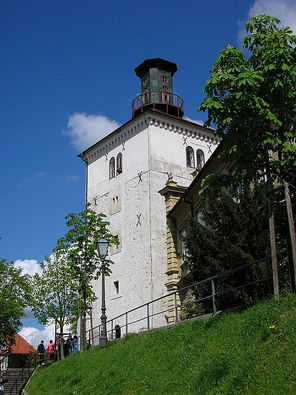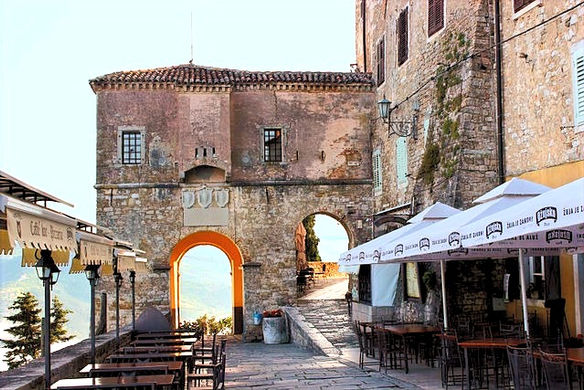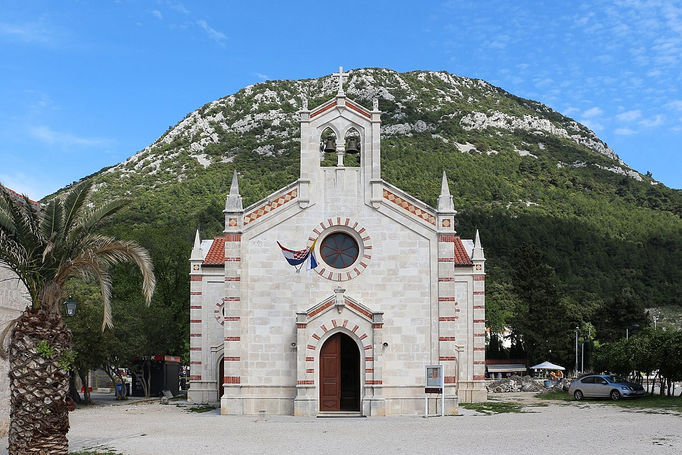

Benvenuto in
CROAZIA


Nome ufficiale: Republika Hrvatska (Repubblica di Croazia)
Capitale: Zagabria
Forma di governo: democrazia parlamentare
Valuta: Kuna Croata (HRK)
Area: 55.960 km²
Popolazioni: 4,2 milioni
Altre città: Dubrovnik, Spalato, Istria, Pola e Zara.
Ancient cities, evergreen forests, sparkling lakes, long stretches of sweeping beaches, rocky coves, quaint villages, enchanting castles and unspoilt nature are some of Croatia's top attractions.
Zagreb
Zagreb, the vibrant capital city of Croatia, is home to some of the country's best museums, galleries, markets, restaurants, and shopping.
The city is divided into two main sections: Upper Town (Gornji Grad) and Lower Town (Donji Grad). The Upper Town is the oldest part of the city, dating back to the 11th century while the Lower Town is a modern area.
The Upper Town and the Lower Town is connected by funicular, which is one of the shortest public transport funiculars in the world, covering a distance of 66 meters and the ride takes 64 seconds.
Jelacica Square
Jelacica Square, the city's main square where the Upper and Lower Towns meet. The Square is flanked by lovely buildings dated back to the 19th century and feature different architectural styles, from post-modernism, to Art Nouveau. The Square is named after Ban Josip Jelačić (1801-1859), a military general and politician who became Ban of Croatia in 1848. You’ll find his monument standing proudly in the middle of the square. Here, you will also find the colorful Tkalciceva Street, filled with sidewalk cafes and restaurants, as well as boutique shops.
The Upper Town
The splendid cobblestone streets, captivating historical buildings, the Upper Town is truly charming part of Zagreb. The remains of town walls and towers that surrounded the Upper Town in the medieval times are still well preserved. It is home to important governmental buildings including the Parliament House and the Constitutional Court of Croatia and some of Zagreb’s top attractions.
The Lotrscak Tower
A fortified tower located in the Upper town, built in the 13th century to guard the southern gate of the Gradec town wall.
Every day, for over hundred and ten years, the cannon fires from the top of tower Lotrščak exactly at noon to give the sign for the bell-ringers of the city's churches.
Stone gate (Kamenita vrata)
The Stone Gate is the last remaining medieval gate in the city and it is the main entry into the Upper Town. In 1731 a fire destroyed much of the Upper Town, burning all the houses to the ground. At that time the Gates displayed a painting of the Mother of God, which was miraculously undamaged by that fire. To commemorate the event, grateful citizens built a chapel within the arch of the old Stone Gate.
St. Mark’s Church
One of the oldest Gothic buildings in the city dating from the 13th century, St. Mark’s Church is Zagreb’s iconic building due to its brightly colored tiled roof. On the roof, you will see the medieval coat of arms of Croatia, Dalmatia and Slavonia on the left side, and the emblem of Zagreb on the right.
Museum of Broken relationship
Devoted to break-ups. You will fascinating collections of donated personal objects and artifacts from old lovers and partners around the world, accompanied by details of the failed relationship. It received Europe's most innovative museum award in 2011.
Cathedral of Assumption of the Blessed Virgin Mary
The Cathedral is the most famous and tallest building in Zagreb. It is typically Gothic style, of great architectural value. Being the tallest building in the city, Its twin spires can be seen from many locations in the city.
Dolac Market
Located just behind the main square, this open-air market is a great place to soak in local life. There are dazzling array of different stalls selling fresh fruit vegetables, meats, dairy products, local handicrafts and artisanal products. It is a very handy place to pick up some souvenirs. The stairway that leads off the marketplace will bring you to Optovina, the city’s main flower market.
Lower Town
The Lower Town is devoted to business, art and spacious parks. The elegant Viennese influences, is visible in the the Lower Town. The streets are mostly wide where most of the city’s museums are interlaced with parks, cafes and classy shops. The main shopping street, Ilica, the National Theatre, the Mimara museum, Roosevelt square , King Tomislav Square and Art Pavillion are located in the Lower Town.
Nella regione centrale della Croazia, il Parco nazionale dei laghi di Plitvice, situato in profonde colline boscose boscose, circonda 16 laghi blu smeraldo, che sono collegati da una successione di fragorose cascate. Gli è stato riconosciuto lo status di patrimonio mondiale dell'UNESCO nel 1979.
Lungo la costa adriatica, antiche città portuali sono piene di edifici in pietra di epoca veneziana, costellate da innumerevoli magnifiche spiagge di ciottoli, che offrono sporto come immersioni subacquee, sci nautico, windsurf o possono semplicemente farti rilassare e godere il sole. Le principali città della costa croata sono Pula, Rijeka, Zadar, Sibenik, Split e Dubrovnik.
Hum
Hum located deep in the hinterland of the Istrian peninsula , is known as the smallest town in the world, which is why it is one of the most attractive Istrian excursionist destinations.
Motovun
Motovun, a medieval village perching on a cliff, overlooking vineyards, olive groves and agricultural land, with houses scattered all over the hill.
A stroll through the town will take you back to those ancient times, and you’ll discover many old gates, towers and defensive walls.
This area is especially famous for some of the finest black and white truffles in the world. Remember to take some of this renowned Truffle home with you! What better way to learn about the history and art of truffle hunting than to go on a hunt yourself with the help of a trained dog?
Opatija
Opatija a vibrant resort where Croatian coastal tourism began, with a history of tourism, dating back more than 150 years.
Stroll along the illuminated 12-km-long coastal promenade known as the "Lungomare". Swim at well-kept Slatina Beach and visit famous seafood restaurants in Volosko.
At its center sits several grand pastel-colored villas and elegant buildings, well-maintained public gardens, with architectural styles ranging from classical to Baroque, Venetian and Gothic. Opatija’s main street, Maršala Tita, has additional examples of lavish Austro-Hungarian architecture. In Opatija, the list of cultural and entertainment events go on and on throughout the year make Opatija a very attractive tourist resort at any time of the year.
Pula
Pula is the largest city in Istria County. It is home to some really well-preserved Roman ruins, including the Pula Arena. It is the only remaining Roman amphitheater in the world with a complete circle wall and was built between 27 BC and AD 68. The city has a long tradition of wine making, fishing, shipbuilding and tourism. You can smell the sea breeze in each corner of its streets and find out its history strolling around the cobbled streets.
Rijeka
Rijeka is the third-largest city in Croatia, after Zagreb and Split. It may not be as popular as other cities in Croatia, but it is a upcoming tourist destination that is worth a visit. In addition to the bonus of having to deal with fewer crowds, you'll be surpirise this long-important port city offers plenty of attractions and things to do.
The Old Town's well-preserved cobbled streets and lanes, lined with splendid examples of architecture that were built in the 1700s. Be sure to visit the magnificent Trsat Castle (Gradina Trsat), built above the town in the 13th century and accessible via a lovely pathway that also leads to the nearby Church of Our Lady of Trsat (Gospa Trsat).
Rovinj
Located on the western coast of the Istrian peninsula, the Venetian-era seaside town of Rovinj is made up of pastel-colored houses and presided over by a hilltop church with an elegant bell tower. It is a popular tourist resort and an active fishing port.
Dalmatian Coast
Centuries-old harbour towns, packed with Venetian-era stone buildings, dramatic coastline dotted with countless magnificent pebble beaches, offering scuba diving, water skiing, windsurfing, sailing or simply relax and enjoy the glorious sunshine. This long, rugged Dalmatian coast, backed by high mountains with hundreds of offshore islands in the Adriatic , is becoming Europe's most popular vacation spot. The main cities are Dubrovnik., Sibenik, Split, Ston, Trogir and Zadar.
Dubrovnik
Dubrovnik, Croatia's most glamorous tourist destination, is referred to as the “Pearl of the Adriatic.”It is a UNESCO World Heritage site, surrounded by the medieval defensive walls. Talk a stroll along the walls, learn about the old ramparts, fortresses , towers and cannons along the way. If you watch “Game of Thrones”, you’ll recognise several locations. The views from atop the ramparts are so stunning! Be prepared to take tons of photos!
Enter the old Town through the famous Pile Gate, one of the city's most impressive structures. Some of the must-see attractions in the Old Town include the cathedral, one of Dubrovnik’s large ensemble of baroque architecture; Square of the Loggia, a historic gathering place famous for its lovely old buildings and monuments; Fort Lovrijenac, one of the country's important fortresses; And the Stradun, a 300 meter long white limestone cobblestones streets, lined with boutiques, cafés, and restaurants.
Sibenik
Although Sibenik is not as busy as other popular destinations within this beautiful country, there's no shortage of great things to do here. In the perfectly-preserved historic Old Town center you'll find the 15th-century Cathedral of St. James (Katedrala Sv Jakova), a UNESCO World Heritage Site and one of the finest churches in all of Croatia, along with numerous elegant 15th and 16th century architecture and attractions that are worth visiting.
Split
Split, Croatia's second biggest city after Zagreb, is famous for Diocletian's Palace, a wonderfully preserved 4th century massive historical complex, that made up half of the Split Old Town. Overlooking the Adriatic Sea, it was built by Roman Emperor Diocletian, who retired here in AD 305. Within the walls, is the pedestrian-only Old Town. Things to see include the magnificent Peristyle, an arcaded courtyard, where you'll also find the Cathedral of St. Domnius with an elegant bell tower. Both the Palace and the Old Town have been proclaimed a UNESCO World Heritage Site in 1979. During summer, it is a popular destination for Sea lovers, soaking in the sun in the Bačvice beach.
Ston
Ston, an idyllic village located in the Peljesac Peninsula, is a perfect escape from the hustle and bustle of cities. It is known for its very well preserved 14th century town walls, its salt works, and its oysters!
The town walls are much longer than those of its neighbour, Dubrovnik, at 5.5 km in length. This makes them the longest defensive structure in Europe; second in the world. They are sometimes referred to as the ‘European Walls of China”. The walls connected the two towns of Ston and Mali Ston, and their purpose was to be the first line of defence for Dubrovnik and to protect their precious salt industry which contributed to the wealth of Dubrovnik. The saltworks were established as far back as the 13th century. The production of salt contributed to the wealth of the Republic of Dubrovnik. It is the oldest salt works still operating in Europe. Mali Ston Bay is where you will find the oyster beds that produce what are often said to be the most delicious oysters in the world! The medieval town of Ston, with narrow streets, noble houses and the Renaissance Bishops Palace that was constructed dated back to the 16th century.
Trogir
Trogir sits on a small island that is connected to the mainland by bridges. A UNESCO site, Trogir looks much the same now as it did in its medieval heyday. Thanks to the careful preservation of its many old buildings, visitors have plenty of attractions to visit, most of them to be found within the confines of the town walls dating back to the 1400s. Examples of elegant Romanesque and Renaissance-style architecture can be seen everywhere along the town's medieval streets or lining the attractive waterfront promenade. Notable among these are Trogir Cathedral , Cipiko Palace, Kamerlengo Castle and the Church of St. Peter.
Zadar
Zadar's car-free Old Town is built on a small peninsula jutting out onto Croatia's Dalmatian coast. The Land Gate is the main entrance to the Old Town. Built during the rule of the Venetians in the Middle Ages, it is adorned with the city’s coat of arms, the Lion of Saint Mark. This impressive structure that once defended the city from oncoming attackers now welcomes travelers from all over the world.
Be sure to check out the 9th-century pre-Romanesque Church of St. Donatus; the 11th-century Church of St. Mary; and the Cathedral of Anastasia and the Church of St. Chrysogonus, both from the 12th century.
Other things to do include visiting the Sea Organ and the monument to the Sun, both on the seafront close to the tip of the peninsula.
Sono presenti dei castelli meravigliosi in tutto il paese ed i principali sono il castello di Trakošćan, il castello di Maruševec, il castello di Ozalj e il castello di Veliki Tabor. Questi sono castelli ben conservati che puoi ancora visitare e ammirare oggi.
Croatia Cuisine
Croatia cuisine is characterized by mainland cuisine and coastal cuisine, but every region has its own distinct culinary tradition. Mainland cuisine has more contacts with Slavic, Hungarian and Turkish, usually meat-based dishes, using lard for cooking, and spices such as black pepper, paprika, and garlic. The coastal region bears the influences of the Mediterranean, in particular Italian, and has plenty of seafood dishes to offer.
We've gathered some mouth-watering Croatian culinary dishes for you to sample on a visit to this unique country.
-
Goulash - very popular in most parts of Croatia
-
Peka – octopus or meat (lamb, veal or chicken) prepared under the bell - literally the food is cooked in a terracotta, covered with a bell-shaped iron lid, and placed inside the fireplace. Peka is often accompanied by potatoes
-
Soparnik - savoury pie with a filling of Swiss chard, speciality of the Dalmatian region
-
Punjena paprika – peppers filled with minced meat
-
Pašticada - braised beef cooked in a fragrant sweet and sour sauce, usually served with gnocchi or homemade pasta. Originated in Dalmatia.
-
Ražnjići - grilled meat on a skewer
-
Jota - a stew made of beans, sauerkraut, potatoes, bacon, spare ribs
-
Janjetina – roasting a whole lamb on a spit, garnished with Mediterranean herbs
-
Black risotto – Risotto with black squid ink ,olive oil, garlic and red wine. Popular all along Croatia’s coastline
-
Brudet - fish stew made with several type of fish (red rascasse, European conger, monkfish, European hake)
-
Buzara - Mussels or shellfish sautéed in garlic, olive oil, parsley, white wine and breadcrumbs. Popular all along the Croatian coast
-
Croatia might be the best place in the world to try oysters! Oysters are grown in the pristine waters of Lim Bay in Istria, near Rovinj, and the Bay of Mali Ston. Just pull a fresh one out of the sea (or order in a reputable restaurant), squeeze a few drops of lemon juice over the delicate meat, and eat it
Some Sweets and desserts not to be miss
-
Kremšnita – custard cream cake, comes from Samobor town.
-
Croatian cherry strudel
-
Fritule - donut-like fried pastries with egg yolks, raisins, grated lemon or orange rinds, and even rakija or rum can go into the mixture.
-
Madjarica – Croatian layered cake
-
Croatian walnut roll
-
Breskvice – Croatian peach shaped cookies
-
Dalmatinski rafioli – ravioli-shaped cookies
And all wash down by Velebitsko, beer from Croatia!

Licitars
Colorfully decorated biscuits made of sweet honey dough that are a traditional culture heritage of Zagreb used by young men to express their feelings towards some lucky girl on a Valentine's day or used as an ornamental gift, given at weddings.
By Seanpu1 - wikimedia.org, CC BY-SA 3.0

La Croazia ha inventato la cravatta. Una cravatta è chiamata cravat in croato.
Le prime cravatte furono indossate dai soldati croati nel 17 ° secolo durante la guerra dei trent'anni in Europa.
By Benjamin C- Pixabay


By Go travelling , Public Domain

By byungjei Lim - Pixabay

By Morana T - Pixabay

By Mrdidg - Pixabay
Brandy di frutta di Rakija, prodotti alla lavanda, cravatte, pizzo croato, tartufi sono alcuni dei migliori acquisti della Croazia.
È un paese bellissimo e sicuramente vale la pena visitarlo per i suoi paesaggi, cultura, monumenti, bellissima costa e altro ancora .... Potresti includere una visita al centro storico
Bosnia Erzegovina o Slovenia.
La fuga perfetta per te!
Lasciati aiutare a creare un ricordo indimenticabile per il tuo prossimo viaggio.
Mandaci semplicemente una e-mail con la richiesta di un tour e aspetta una nostra risposta per il preventivo, basato sulle tue esigenze e aspettative!






























































































































